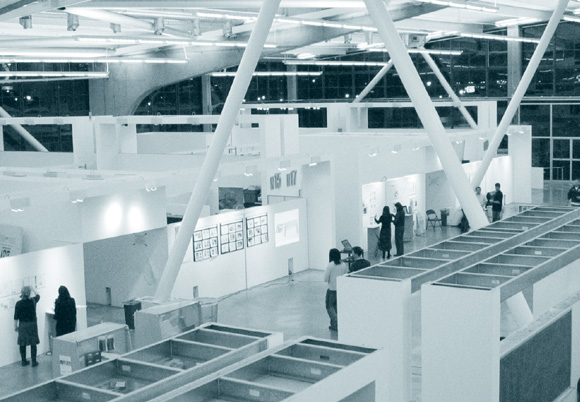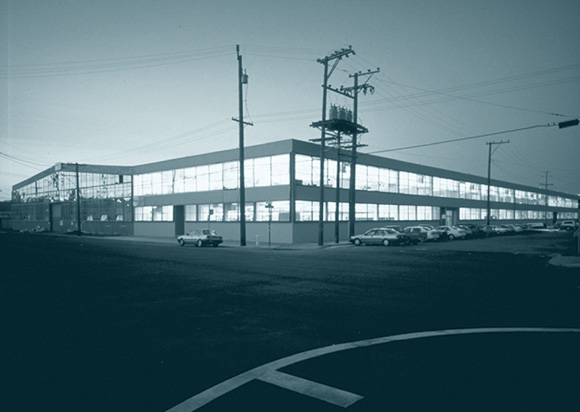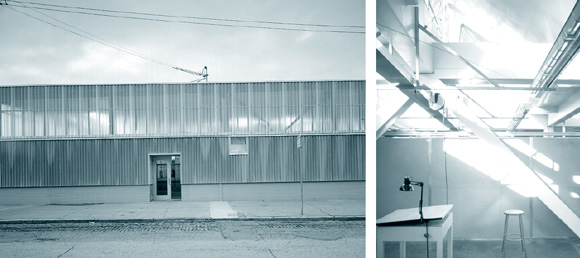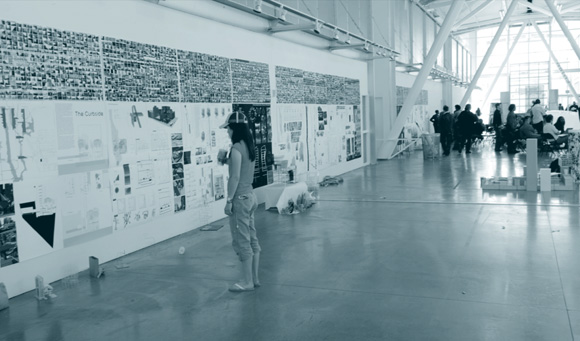
This year marks the California College of Arts centennial. Since David Meckel joined the California College of the Arts over twenty years ago, the school has added several award-winning spaces to its campuses. Jim Jennings and Mark Horton have completed new buildings on the Oakland campus, and Leddy Maytum Stacy and Jensen + Macy have either renovated or designed new buildings on the San Francisco campus. Yet Meckel’s view of the institution’s patronage extends beyond building commissions into its role as an urban catalyst and in educating the public, corporations, and even their own patrons. arcCA contributor Kenneth Caldwell interviewed Meckel in his light-filled San Francisco office.
arcCA: Can you define the concept of patronage in architecture?
Meckel: To me it implies an investment—you invest in relationships with designers, and you learn how to achieve a better result by going through the design and construction process multiple times. With an ongoing relationship, you learn to leverage each other’s assets.
arcCA: What about the difference between architectural patronage in Europe and architectural patronage here in the U.S.?
Meckel: You are seeing business step into that role in a way they probably haven’t done in about forty or fifty years, since IBM and Polaroid and some of the big corporations made their name because of their affiliations with people like Eliot Noyes, Herbert Bayer, and Charles Eames. Once again, corporations are seeing the value of design, with the designer in the role of trusted advisor. But, historically, Europe has always been ahead of us in the sense of state-sponsored projects being more holistic, taking a longer-term view—which is why they were out ahead of us on sustainability.
arcCA: Can you talk about patronage in terms of the outreach role that an institution like this can have in teaching companies the benefits of being patrons?
Meckel: In any given semester, we partner with companies, some of which are already invested in design. For example, we did a studio with Design Within Reach this past fall. But we also did a studio last year with Simpson Strong-Tie, looking at connectors with the idea of bringing prefab thinking to on-site construction methods. They don’t think of themselves as a design company, since they make joist hangers and other connectors that they describe as “sharp, oily, and ugly.” Our hope for that class was that we could look at their DNA and say, “Okay, how could we extend that DNA into beautiful products that they don’t yet make?”
arcCA: And do you see that as a growing opportunity for this institution to educate people who could become patrons?
Meckel: A little bit. That is, of course, our role in dealing with contemporary visual culture: that we would make design more valued and more visible. And we do when we get these sponsored projects. Last year, we did one with a Turkish pet accessory company. And the students took that to the Milan Furniture Fair.
I think what you’re asking, though, is something that I don’t feel we’re well equipped to do. If you went to Yale (or Brown or Harvard) thirty years ago, you would have been taught by Vincent Scully or another great architectural historian. You knew you weren’t going to become an architect; you were getting your business degree or law degree or whatever. But you were going to become a citizen. And part of the university’s role was to make you aware of and put you in a position to leverage the creative forces of our economy.
Because we’re such a specialized school, we’re preaching to the choir. By the time somebody gets to our doorstep, be it a student or a company, they are at least halfway there.
We have had some success going at it another way, by having a public component to the college, which is called the Center for Art in Public Life. [http://center.cca.edu] We send students and artists out into the community, and we’re just finishing up a project in the East Bay called “100 Families Oakland.” We’re working in the community, using art-making as a tool to bring families together. So it’s part social intervention and part creative intervention. That kind of outreach work tends not to be pointed at national corporations. It tends to be pointed locally.

arcCA: Let’s talk more about your impact on local communities as a kind of patronage. Maybe we should be talking about influence rather than patronage. You once said that you thought it was good for a school to move its campus every ten years. Do you still think that’s true?
Meckel: I do think it’s true. While I love our Oakland campus, there was a built-in template to the way education could be done there. Ceramics didn’t really have any kind of conversation with sculpture. There are discrete buildings with virtually no relation to each other. The campus we developed here in San Francisco is actually probably an overreaction to that.
When we started to invest in our San Francisco facility, the goal was the opposite of the result in Oakland. How could you—even though you’re going to suffer on the acoustic front—do something where just by the act of walking through the studios you participate in the creative life of the school? By being that open, happy accidents happen. While we all had great professors, we often learn as much from our fellow students. And you do that late at night when you’re eating pizza next to each other. And that’s hard to do if everybody goes in a studio and closes their door.
We were over on 17th Street where Jamba Juice is now, and we had a really hard time finding space for expansion. I went and talked to Lu Blazej in the planning department, and he was impressed by what we had done in terms of the impact on the community.
arcCA: What do you mean?
Meckel: When we moved in over there, the only liquid available within a mile radius was probably a screw-top bottle of Thunderbird. By the time we were ready to expand, you could get twenty kinds of lattes and scones across the street. But it wasn’t gentrification; it was the kind of vibrancy you get from student life. So Lu said something like, “Could the planning department use you guys and just move you every ten years, because you’re like a little incubator in whatever neighborhood you go to?” So he was thinking of it more from the life of the city, that a school could, as we have done here, generate community around it in a non-confrontational way.
While the neighbors here have stopped all kinds of projects from ball parks to Home Depots, everything we’ve done they’ve supported, because they like having students working for them, shopping in the neighborhood, living in their rental units, and going to the restaurants. So, in that sense, moving has a good urbanistic component. We have, however, purchased these facilities. So, we’re going to aggregate around them.
But we’re well aware that it’s just good for the lifeblood of the place to not hunker in and say you’re never going to change anything.

arcCA: Is there any relation between the selection of architects for a CCA project and architectural pedagogy?
Meckel: We are the most unlikely of patrons. We have no state money, no federal money. But we have a great board of trustees, and we’ve had some amazing presidents and CFOs who understand the bond and real estate markets. We go into projects knowing we’re going to have to cut everything out of them. You could say that is a formula for disaster, for not doing good architecture. I think where those constraints meet opportunity is a form of pedagogy that exists in our program—a kind of functionalist inventiveness of how you make things. And so we have tended to hire architects who do more with less, who basically go into it knowing that it’s not going to be the materials; it’s not going to be the surfaces. It’s going to be about daylight and spatial order.
First, I think, “Can whatever we do accept the punishment and changes it’s going to get inflicted with?” So, stay away from anything precious. And then, secondly, “At what moments do larger concerns beyond the walls of our campus, say sustainability, intersect with an elegant solution?” So, did we go into this saying, “Gee, we should have a solar heated building”? No, we went into it saying, “We have a 35-foot-high volume with single-glazed windows. We’re never going to meet Title 24. Even if we get heat in this space, only the pigeons will be warm.” So, eventually you get to a radiant slab once you go through that exercise. And a pretty easy way to heat a radiant slab is with solar panels.
As we make the decisions, we are always testing them against “We should practice what we teach.” In other words, the DNA of the buildings should embody the kind of values that we would like to transmit, because when we’re not teaching, we’re still transmitting them.
Doing these beautiful projects with so little money has proved to me that having a small budget is no excuse for bad design.
arcCA: Besides being a client for projects by some of the leading lights of the Bay Area, can you talk a little bit more about how CCA fulfills a role as a patron of design?
Meckel: In addition to the urbanistic component I mentioned, the faculty has an off-campus role within a larger community. For instance, Mitchell Schwarzer, who is head of our visual studies curriculum, has also written a critical guidebook to architecture in San Francisco. He could have just as easily done yet another book on modern German architectural theory, which only a handful of scholars would have read. But I think being at CCA has encouraged him to direct his scholarship to engage the region. As a member of the faculty, you possess a kind of political diplomatic immunity that a lot of other people don’t have. So the press calls us to comment on local architectural culture. Many of us also serve on award juries, selection committees, and non-profit boards—all supporting the patronage of design and architecture.
arcCA: Can you comment some on how the institution influences its own patrons? Do they change their pattern of giving or their goals as a reaction to the architecture?
For example, the large open spine at the San Francisco campus does not have several obvious naming opportunities. But you stuck to a kind of Miesian universal space idea anyway.
Meckel: That space is the heart of a dynamic campus. The goal of most educational or other non-profits is to have their philanthropy be as non-restricted as possible. It doesn’t help a non-profit if the gift adds pressure to the operating budget by creating new initiatives. In our case, the push is towards student scholarships. Having said that, there are buildings and spaces that suit the named-gift strategy well, and we’ve tried to match those with interested donors. I think that our donors are excited by the gestalt of the architecture in use and its synergy with our mission. Since we haven’t named everything down to the water fountains, their expectations are often in line with what we already do. When we are in session, there is no facility I would rather walk a donor through than our campus. When trying to secure a gift, what matters is that the energy is palpable, and that’s because it’s not all hidden away behind closed doors, it’s out in the open.

San Francisco Museum of Modern Art presents
California College of the Arts at 100: Innovation by Design
Friday, March 23, 2007 – Sunday, August 26, 2007
This exhibition of works from SFMOMA’s architecture and design collection is a tribute to the centennial anniversary of the California College of the Arts (CCA). The exhibition features works by such esteemed architects and designers as Yves Béhar, Thom Faulders, Donald Fortescue, Mark Fox, Jim Jennings, William Leddy, Jennifer Morla, Jennifer Sterling, Lucille Tenazas, Michael Vanderbyl, and Martin Venezky. CCA’s faculty and graduates have influenced—and, in many cases, led—almost every mid- and late-20th-century art movement. Throughout its history, SFMOMA has provided an active forum for examining issues of architecture and design in relation to modern art; this exhibition maintains the Museum’s commitment to the collection and exhibition of experimental design and theoretical architecture in the Bay Area while celebrating the students and faculty of an important educational institution. It will include a separate section on all the buildings and graphics CCA has commissioned for itself.
Originally published 1st quarter 2007 in arcCA 07.1, “Patronage.”





